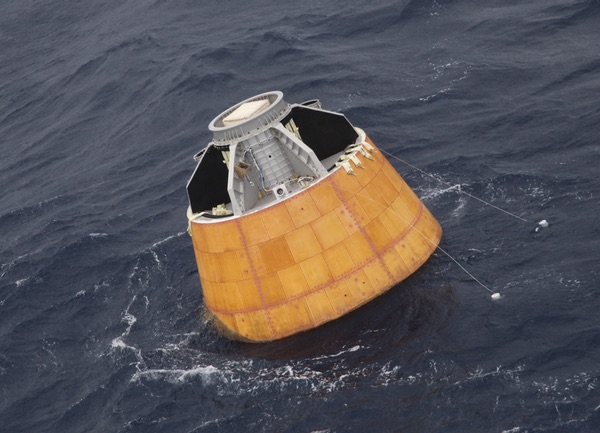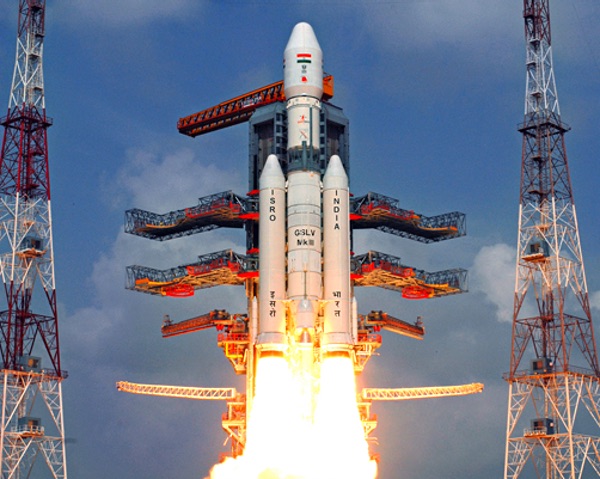India’s heavy-lift rocket and crew module milestones: which is more important?by Ajey Lele
|
| There has been a certain perception that ISRO has found a “comfort zone” with its PSLV design and thus organizes all its activities around that vehicle only. |
India became a spacefaring nation on July 18, 1980, with the successful launch of its satellite Rohini (RS-1). With this milestone, India joined a select group of five countries in the world at that time to develop their own launch vehicle capabilities. It was the most important milestone for India’s space program. This success was a result of a hard work by the scientific community almost for a decade. They had their failures, as well. The first success came with the second experimental flight of SLV-3 (Satellite Launch Vehicle-3), which successfully placed Rohini satellite into an orbit. ISRO found this vehicle useful and made one more successful launch using this technology. The entire process of development of this vehicle helped India in developing various other important technologies related to launch vehicles in general.
Subsequently, India realized there was a need to inject satellites into a very accurate orbit. Also, satellite systems were becoming much heavier. Hence, it was decided to upgrade the SLV-3 platform. The Augmented Satellite Launch Vehicle (ASLV) was developed, which could place satellites weighing up to 150 kilograms (Rohini was a 35-kilogram satellite) into low Earth orbit. ASLV was not very successful as a launch vehicle, and out of its four launches only one was able to put its satellites into the correct orbit. During the same period, ISRO was also working on Polar Satellite Launch Vehicle (PSLV) program, capable of launching 1,000-kilogram satellites. The first flight of PSLV, in 1993, was a failure, but the consistency of this vehicle has subsequently been outstanding. Through end of 2014 it has performed 27 consecutive successful launches.
There has been a certain perception that ISRO has found a “comfort zone” with its PSLV design and thus organizes all its activities around that vehicle only. In the last decade or so, ISRO has made various configurations of PSLV which could be used for specific missions. To carry heavier loads, it has developed a type with strap-on motors. The PSLV also has been used to undertake multiple satellite launches in a single rocket launch. Interestingly, even for deep space missions like missions to Moon and Mars, the same rocket technology was put to use.
The Geosynchronous Satellite Launch Vehicle (GSLV), which was first tested in 2001, has also made use of PSLV technologies for portions of this vehicle. The GSLV Mk I and Mk II are three-stage vehicles where the first stage is solid, the second stage liquid, and last stage cryogenic. For these launchers, the first and second stages have been borrowed from the PSLV design.
However, this is not the case with LVM3, for which new solid and liquid stages has been designed. The entire GSLV system would be a three stage vehicle and with LVM3 India has tested the first and second stage. The third, cryogenic stage for this vehicle is still under development and could take another two years to complete. What India has essentially conducted is a suborbital test, successfully demonstrating only part of the new GSLV rocket.
Developing cryogenic engine technology has been a major challenge for ISRO for two decades. During early 1990s, the United States ensured that transfer of this technology from Russia to India was denied because of the possibility that India would use this technology to boost its missile program. US authorities accomplished this by imposing sanctions on Glavkosmos, the Russian company providing technology to India. Subsequently, India has spent significant time developing this technology. There could be various reasons for this delay, including technological failures. However, one reason that usually gets overlooked is that Mr. S. Nambi Narayanan, a scientist heading the cryogenics division in 1994, was falsely implicated in an espionage case and arrested. The case against him was eventually dismissed. but his personal and professional life was permanently ruined and ISRO’s cryogenic programme suffered significantly.
| During this test both the solid and liquid stages performed as the expectations boosting the confidence of ISRO scientists. But, the major challenge still remains: the development of cryogenic engine for GSLV Mk III. |
The first “made in India” cryogenic engine was used to launch a satellite in April 2010, but this mission was a failure. The engine was infally successful in a January 2014 launch (see “GSLV-D5 success: A major ‘booster’ to India’s space program”, The Space Review, January 6, 2014). The satellite lifted on this mission (GSAT-14) weighed slightly less than two tons. It was a hard work for scientists working on ISRO’s Cryogenic Upper Stage Project (CUSP). This main engine, and two smaller steering engines of CUSP, together have apability to develop a nominal thrust of 73.55 kilonewtons in vacuum. The rocket used for the January 2014 GSLV Mk II launch could carry about 2 to 2.2 tons to geostationary orbit. However, ISRO is developing GSLV Mk III to carry heavy payloads weighing four tons or more.
The December 18 suborbital experimental LVM3 mission tested the vehicle performance during the critical atmospheric phase of its flight. The configuration for this flight was two solid stage boosters (S 200) mounted on the L110 liquid stage and a passive (non-functional) cryogenic upper stage. During this test both the solid and liquid stages performed as the expectations boosting the confidence of ISRO scientists. But, the major challenge still remains: the development of cryogenic engine for GSLV Mk III. The engine developed for the GSLV Mk II is not adequate and more advancements are required to carry a larger payload. That probably requires an engine than can generate more than 90 kilonewtons of thrust in vacuum.
In January 2007, ISRO launched Space Capsule Recovery Experiment (SRE-1). This 550-kilogram capsule stayed in orbit for ten days and then was deorbited and recovered back on Earth, demonstrating the capability to recover satellite from orbit at a predetermined location. Surprisingly, no follow-up to this mission was flown; SRE-2, which was expected to be a more advanced vehicle, was never launched.
 The experimental crew module, known as CARE, floating in the ocean after splashdown on its brief suborbital test flight. (credit: ISRO) |
Now, with the success of CARE, it appears that ISRO is revisiting this reentry technology project in a more nuanced way with a specific end result in mind. For the CARE mission, ISRO launched the 3,775-kilogram Crew Module (CM) on a suborbital flight. The LVM3 rocket carried the CM to a height of 126 kilometers and subsequently released them CM from the upper stage. It took around five minutes to reach to this height after the launch. Over the next fifteen minutes, the CM reentered the atmosphere and deployed parachutes before landing over a designated zone in the Bay of Bengal. The ships of the Indian Coast Guard recovered the CM in a perfect condition, demonstrating that ISRO has mastered the art of reentry technology.
| A human space mission for India is still a distant dream. It may take another ten years for India to put a human in space. This is not a top priority program for India at this juncture. |
Overall, the LVM3/CARE mission could be viewed as a successful beginning for a specific space agenda for tomorrow. There have been specific phases of development over ISRO’s history, depending on the requirements of the country. India being mainly an agricultural economy, the initial emphasis was to develop multipurpose satellites that could be used for applications like meteorology and communications. Remote sensing satellites remain the core of India’s space agenda even today. These satellites have various applications, from land and water resources management to disaster monitoring. Now, India is halfway through the process of developing its own regional navigation system.
ISRO has mastered the art of launching two-ton satellites but doesn’t have the capability to launch larger satellites, weighing four to six tons. India has had to purchase launches, primarily on Ariane launch vehicles, for those heavier satellites. India is trying to reduce this dependence and is also keen to enter into the global satellite launch market to launch heavy satellites (its PSLV is already launching smaller satellites for other states on commercial terms.) For all these reasons India is developing a new satellite launching system and it has achieved a limited success in that direction with the LVM3 launch. ISRO expects that, within next two years or so, it will be able to fully operationalize GSLV Mk III.
A human space mission for India is still a distant dream. It may take another ten years for India to put a human in space. This is not a top priority program for India at this juncture. ISRO is expected to develop this program slowly but steadily in the next few years. The crucial focus for India should remain on the development of heavy lift launchers and, hence, the development of cryogenic (and semi-cryogenic) technology. This is the technology that would give India a reliable heavy-lift launcher required for most of their future missions, be it the launching of communication satellites, expanding commercial interests, undertaking deep space missions, or launching humans into space.
